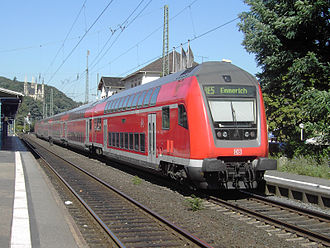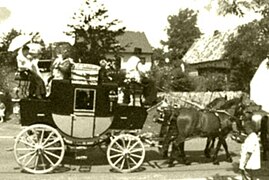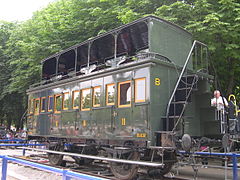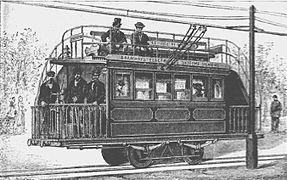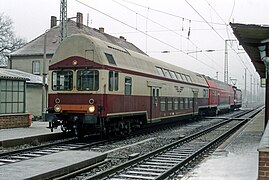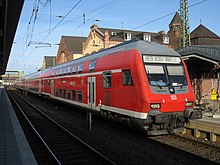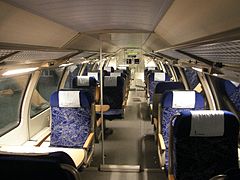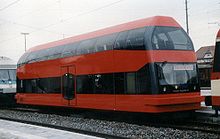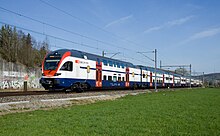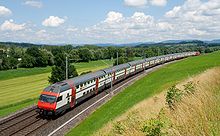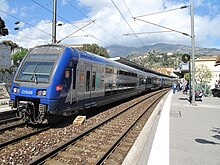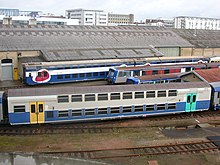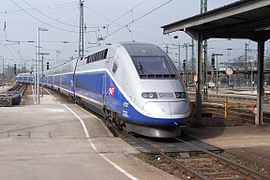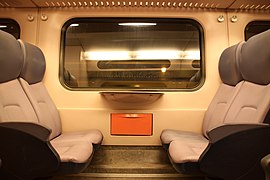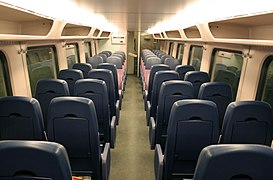Double deck car
A double-deck coaches , colloquially double-decker , double-decker or short Dosto called, is a railroad - or tram cars or - railcars with seats in two superimposed planes. Compared to single-story passenger cars , double-decker cars of the same length can accommodate more passengers , which increases capacity, especially on short platforms . The structural limits are determined by the clearance profile .
history
The first trams and omnibuses were built with two floors early on in order to be able to transport more people - the latter is known as a double-decker bus . Double-decker trolleybuses were built later, and more recently, double-decker cable car gondolas (such as the new Stanserhorn cable car ).
The principle was used by the stagecoaches used, where often on the roof of the driver's seat were and often additional passenger seats. The roof was already used for additional passenger transport on the first passenger carriages on rails ( horse-drawn trams ) that were still pulled by workhorses , and fixed seats were also installed on the roof of some carriages . Compare the history of the Stockton and Darlington Railway . In general, land vehicles transporting people with an open upper deck are referred to as deck seat wagons or, in the case of horse-drawn trams, as imperial wagons .
Railroad St. Petersburg - Peterhof 1864
"Imperial carriage " of the Dresden horse tram , from 1872
Interlaken: train the Bödelibahn with Lok hair dryer and double-deck cars
Model of Krauss-steam railcar 1882
Double-deck coaches were delivered to the Altona-Kieler Eisenbahn as early as 1868. The cars were designed as compartment cars at the bottom and as passage cars at the top and had cranked steel side members. There was space for 50 travelers downstairs, and 32 spaces were offered on the upper floor. In the same year, Sjaellandske Jernbaneselskab acquired double-decker cars in Denmark. 60 passengers could travel in the lower part of the car, 40 in the upper deck. In 1873 the Staats-Eisenbahn-Gesellschaft (StEG) also introduced double-deckers in Austria . Only one year later, the Austrian Nordostbahn (NOB) followed this step. The Lower Silesian-Märkische Eisenbahn ordered twelve shelf cars in 1873, but the cars were not used until 1876. They were the first vehicles to be used on the Berlin Ringbahn .
The French Compagnie du chemin de fer Bayonne-Anglet-Biarritz between Bayonne and Biarritz used double-decker passenger coaches around 1876, while the coaches of the Lartigue Feurs-Panissières monorail in France from 1895 had open seats on the roof that were secured with wire cages. The state railway ETAT and the French Eastern Railway EST also started using double-deck cars from 1879.
From 1883 double-deck steam railcars became popular. The Hessische Ludwigsbahn and the Royal Bavarian State Railways are among the first railway companies to use them .
Germany
LBE wagon
The first modern double-decker railway cars were used in Germany from May 1936 by the Lübeck-Büchener Eisenbahn (LBE) as express trains on the Hamburg - Lübeck - Travemünde Strand route. Back then they were already equipped as push-pull trains with a control car compartment , automatic Scharfenberg couplings and as double units with a common Jakobs bogie . After successful operation with initially one unit, six more double-deck cars were built at the same time by the companies WUMAG in Görlitz and Linke-Hofmann-Lauchhammer AG in Wroclaw . The LBE No. 1 to 3 steam locomotives used with the train were express train tank locomotives with streamlined cladding that could be remotely controlled by the driver from the other end of the train .
The LBE double-deck coaches had second and third class compartments, with the second class compartments being marked on the outside with a yellow color scheme compared to the gray-green on the other compartments. The seats in both second and third class were padded; the cars had air conditioning . Larger luggage was removed by bellhops when boarding, stowed in the luggage compartment and returned when leaving the car.
When the LBE was absorbed by the Deutsche Reichsbahn on January 1, 1938 , the double-deck cars were also taken over. The express traffic between Hamburg and Lübeck was then no longer operated in push-pull train operation, but in normal train service. The air conditioning systems were also no longer operated.
Broad gauge railway

In May 1942, the Reichsbahn and the Reich Ministry of Transport were commissioned by Adolf Hitler to develop a broad-gauge railway . Double-decker cars in an extremely luxurious design were provided for passenger transport. The project finally failed in planning in May 1945 at the end of the war.
German Federal Railroad
After the Second World War , the German Federal Railroad used the double-decker coaches again on the main Hamburg – Lübeck route for express trains . With the reintroduction of Wendezugbetriebes from May 1959, the former LBE biplane were again as a control car with a biased diesel locomotive type series V 200 used. After four cars were taken out of service, the remaining four double-deckers ran as reinforcement cars in the push-pull train service Hamburg – Lübeck. Despite their small number and the associated maintenance costs, the cars lasted until September 1977 because of their large amount of space on the Hamburg – Lübeck route and were retired in 1978. After more than 25 years, modern double-decker cars have been driving on this route again since 2006.
At the beginning of the 1950s, the Federal Railroad developed new double-decker single wagons with a length of 22.4 and 26.4 meters and recessed end entrances at the end of the wagon and a central entrance in the lower area.
22.4 meter long cars with the generic designation DBC4üpwe-50 (later DAByg 548) with a luggage compartment, DC4üpwe-50 (later DByg 546) and DCR4üpwe-50 with dining room and kitchen (later DByg 547) with full windows were built. Since the buffet compartment had not been successful, it was extended later, the cars were 1955 UIC - sliding windows . But it stayed with the prototypes , which were mainly in express trains in North Rhine-Westphalia, u. a. drove on the Eifelbahn . Three more prototypes were given the later UIC standard length of 26.4 meters. Here, too, a DC4ümg, a DBC4ümg and a DBCRümg (which also later lost the dining compartment) were built. With these six prototypes it stayed with the DB. All of the cars were initially painted steel blue, in 1955 they were painted bottle green, and then in 1967 in chrome oxide green.
For the new Rheingold long-distance train , five dining and viewing cars, some of them double-decker, were built in 1962 . The upper part of the dining car served as a storage room; In the observation car there were post and luggage rooms under the observation pulpit.
In 1989, on a trial basis, individual S-Bahn trains operated with Dutch double-decker cars on the Munich S-Bahn line . Despite the fact that the test was satisfactory, the use of the S-Bahn was refrained from, particularly due to the long passenger switching times in rush hour traffic.
German Reichsbahn
Multi-part double deck units

In 1952, VEB Waggonbau Görlitz (formerly Waggon- und Maschinenbau AG (WUMAG)) developed two- and four-part double - decker trains based on the LBE vehicles for the German State Railroad in the GDR . Of the 39.9 meter long and 76 tonne two-part DB7, later DBz, Görlitz delivered only twelve units in 1955. They had 228 seats and 210 standing places. The four-part 73.4 meter long DB13, later DBv, were represented with 152 units in the DR equipment park. They offered a total of 906 passengers. Two-part and four-part units were almost identical, with the two-part units only missing the intermediate car.
As with the LBE wagons, two individual wagons each rested on a Jakobs bogie , the doors were above the bogies . For reasons of axle load, especially when used on branch lines , the Jakobs bogies, unlike those of the LBE wagons, had three axles. The car body was designed as a self-supporting all-steel lightweight construction. In terms of running technology, the vehicles were designed for 120 km / h; in terms of braking, the permissible speed was initially 100 km / h. The units were delivered with Hildebrandt-Knorr passenger train brakes, due to the high proportion of passengers in the total mass, with automatic load braking (Hik-GP-A) from the start. The wagons had two double doors on both sides with a clear width of 1.5 meters in the one-story area above the bogies. In the end car there was also a toilet and a service compartment in the one-story area. Internal doors between entry and passenger compartments were not provided for in the two-part and four-part units. The windows on the upper floor were divided, the lower, vertical part could be opened with a crank. The upper third of the remaining windows could be folded inwards. The seating arrangement was 2 + 3 with half-height backrests, when the third car class was abolished , the vehicles were reclassified to second class. The transition between the cars was protected with bellows. A large part of the delivery only had steam heating from the factory , the electric heating was retrofitted later. Entrance and transition doors were equipped with bar locks.
The four-part series were also in large numbers to other railroads of the CMEA delivered and are partly there still in use, such as in the Polish PKP and the Romanian CFR consuming modernized (air-conditioned and wheelchair accessible), which some units.
From 1957 five-part double - decker articulated trains (DGB [e]) were delivered, in which the end and intermediate cars were connected by short intermediate cars (DGZ) that were supported on the bogies . The intermediate cars contained the entry areas and were led vertically and horizontally bisecting the angle by means of handlebars between the neighboring cars. Between the entry and passenger areas there were sliding doors on the lower floor and double-leaf swing doors on the upper floor . The toilets were under the stairs to the upper floor, so they were a bit cramped. A total of 33 units were delivered. This long-distance transport variant with high transitions was supplemented by five double-decker buffet DGR and matching luggage trolleys DDg [e]. However, despite their roof shape and the high transitions, these luggage trolleys were only one-story. The car bodies of the middle and end cars were self-supporting constructions made of thin-walled folded profiles. The pipes in the passenger compartment, to which the seat frames and luggage racks were attached, were part of the supporting structure as reinforcement. On the upper floor there was a prominent step between the center aisle and the compartments. Despite the lightweight construction, the axle mass was problematic with a large number of people. If this reached 200 percent, the axle mass of the intermediate cars also exceeded the values permitted on main lines. The double-decker articulated trains also had the Hildebrandt-Knorr-Bremse Hik-GP-A.
In 1961 four-part double-decker trains were delivered again, which outwardly resembled the design from 1952 to 1955, but whose car bodies were designed according to the lightweight construction principle of double-decker articulated trains. This reduced the vehicle mass of the four-part unit from 145 to 131 tons. The seat design and division (2 + 2 with high backrests) also corresponded to that of the articulated trains, but the floor was even on the upper floor. A modified room layout at the ends of the unit made it possible to accommodate two toilets and a small service compartment. From the 1961 design onwards, all double-decker vehicles were supplied with Knorr-Bremse with unitary effect (KE-GP-A). The permissible speed was 115 km / h, after a few years it was increased to 120 km / h. The speed increase also affected the vehicles from the delivery years 1952 to 1955.
From 1970, the construction of 31 five-part double-decker articulated trains (DGBgq [e] with push-pull control compartment, DGBgu [e] only with control line) began for use in urban traffic, with the car transition at the non-driver's cab end at normal floor height. In order to avoid exceeding the axle load and to allow the vehicles to be used freely, the end and middle cars were shortened by one compartment each. For the first time, the windows on the upper floor were completely in the roof slope, they could be opened upwards. The end cars were prepared for the installation of the automatic central buffer coupling . The stairs to the lower floor were only planned on one side, the toilets were in place of the stairs that were no longer available. The doors between the entry and passenger compartments corresponded to those of the 1957 design. These units were used in chemical workers' traffic in the greater Halle / Saale area, in express traffic between Leipzig and Halle, in Sputnik traffic on the Berlin outer ring and on the S-Bahn from Dresden, Leipzig and Halle and Magdeburg used. They ran on Görlitz VI-Do-K bogies . The entrance doors were locked with Kiekert locks, making the door handles asymmetrical. For the first time a door locking device was installed, but usually not used.
The last four-part units with Jakobs bogies were delivered in 1971. These were also given a push-pull train control compartment; the entry area behind it was separated from the passenger compartment by doors as a service compartment. As a result, older units were also equipped with a control compartment, and worn doors with rod locks were replaced by sandwich-type doors with Kiekert locks.
The double-decker and double-decker articulated trains were retired in Germany until 1995. The double-decker articulated trains from 1957 were retired at the beginning of the 1980s because of their different design with the high-level crossings, after they had been withdrawn from high-quality service ten years earlier. Because intermediate wagons that were no longer worth refurbishing were taken out of service beforehand, three- and four-part double-decker and double-decker articulated trains have also been running in recent years.
Double-deck single car
In 1974 the construction of double-deck single wagons began (two sample wagons had already been built in 1972). In terms of design, these vehicles, known by the manufacturer as double-decker standard seating cars, were based on the double-decker articulated trains from 1970. However, they had entry in the lower level instead of in the higher mezzanine, which made it much easier to use with loads and ensured stepless entry with a platform height of 550 millimeters. The installation of external sliding doors made it possible to dispense with door pockets and simplify the box construction. Here, too, the transition is at the normal floor level of the car, as is the case with single-story cars, which made it possible to freely couple with other through cars . These cars became the forerunners of today's double-decker cars with low-floor entry . Görlitz delivered 672 cars of this type, including 100 control cars. From 1986 the new vehicles were delivered with disc brakes . The double-deck single wagons are still in use today in the form of several modifications in the S-Bahn networks and regional train lines, mainly in the new federal states.
The double-decker coaches were mainly used in S-Bahn and suburban traffic . They were popularly called Wendeei . Due to the beige-brown color scheme of the double-decker single wagons introduced in 1979 (before the wagons were painted dark green), the designation mustard pot was also common. The prototypes were delivered in these colors, but they had blue painted doors. These should make it easier for travelers to find the entrances. The wagons for the Berlin suburban traffic were delivered in the then current "capital city paint" wine red and ivory. After extensive modernization from 1992, the cars are still in use. They received additional windows, swivel sliding doors that were flush with the outside wall when closed, and a completely new interior design. The control cars were converted in the same way, first-class compartments were installed on the side of the car behind the driver's cab. From 1997 onwards, a number of control cars received modern GRP heads.
Deutsche Bahn

From the mid-1990s, the newly developed double-decker wagons by Deutsche Waggonbau (formerly Wumag and Kombinat Eisenbahnfahrzeugbau , now taken over by Bombardier Transportation ) were increasingly used throughout Germany. These are typically hauled as push-pull trains with electric locomotives of the series 111 , 112 , 114 , 143 , 146 , 147 , 182 or 193 but also with diesel locomotives of the series 218 or 245 and have the converted Silberlinge and Halberstädter center entry cars on many routes , in some cases also the DR -Double-decker coach replaced.
In 1992 Waggon- und Maschinenbau in Görlitz built 100 new DABgbuzf control cars, which were later given the type number 760. Because of the decreased volume of traffic after the fall of the Wall in the GDR, there were more intermediate cars than were needed. In order to be able to form more push-pull trains, new double-decker control cars were built, especially as the decline in freight traffic meant that more electric locomotives of the class 143 were free for push-pull trains. Because the DR's regional trains were also supposed to run in first class, a mixed-class vehicle was implemented. The clearance profile of the wagons has been expanded compared to the previous DR designs in order to gain more shoulder room in the upper floor. For the first time, the cars received arched windows on the upper floor. An exemption from the Federal Minister of Transport was required for this, because the car outline exceeds the permissible UIC clearance profile. The driver's cab corresponds to that of the 143 series, but is kept in light colors. For the first time, in addition to the conventional push-pull train control with 34-pin control line, the time-multiplex push-pull train control was installed, which not only offers the function of up-down control , but also the full main control with speed preselection.
These 26.8 meter long vehicles were delivered in mint green, light gray and white , in accordance with the DB product colors for local transport at the time . So they matched the modernized DR single wagons, which had also received the then current DB local traffic paint. The entrances in the lower floor are in the same position as the previous single wagons, but for the first time, when closed, swivel sliding doors flush with the outside wall were installed. There are 96 seats in the second class, 28 in the first, which is located at the end of the driver's cab across both floors. The cars are approved for a maximum speed of 140 km / h with the built-in Knorr-Bremse with unitary action and automatic load braking KE-PR-A. A magnetic rail brake can be retrofitted, but has not yet been installed.

The first double-decker coaches of the former Federal Railroad were ordered at the beginning of 1992. The 75 vehicles were intended for the Munich area . The order only included second-class intermediate cars (55 units) and mixed-class intermediate cars (20 units). Both types had the doors above the bogies.
These cars were built under license from Schindler's cars for the Zurich S-Bahn , based on a patent from the French CIMT (Compagnie industrial de matériel de transport). The electrical equipment came from ABB Switzerland , the bogies from SIG . Originally the cars were supposed to be built by Schindler, but for political reasons the order had to be converted into a license agreement for Görlitz after the fall of the Wall . Immediately thereafter, further double-deck cars were procured, as well as control cars. In 1996 the first double-deck cars with air conditioning were put into service by Deutsche Bahn AG, and since then all double-deck cars have been purchased with air conditioning. Some non-air-conditioned cars have recently been modernized and also have air conditioning. Cars that come from the DR inventory have not yet been equipped with an air conditioning system.
Since 1997/98, bogies with magnetic rail brakes have often been installed, so that wagons equipped with them are approved for fast regional express traffic at 160 km / h. First, regional express lines running at a top speed of 160 km / h were introduced as planned in Berlin-Brandenburg , but can now also be found in many other parts of Germany. In 2008, wagons with a maximum speed of only 140 km / h were put into service for Hessen.
The head shape introduced in 1997 has so far been given to all other control cars from Görlitz. Most of the DR control cars procured up to 1990 were also converted to this head shape in 1997/98. The double-deck coaches have been continuously developed in recent years, so that there are numerous differences between the individual series. Individual construction lots are often procured specifically for certain areas of use, some of these wagons have some special features in terms of equipment - some wagons are equipped with snack vending machines, LED lighting or seat reservations.
Since the end of 2015, DB Fernverkehr has also been using new double-decker trains in IC traffic. These were originally intended to supplement the old fleet of vehicles until the ICE 4 multiple units were delivered and then to be handed over to DB Regio . Even after the ICE 4 has been delivered, the wagons should remain in stock and be used partly as a reserve, partly as wagons in planned services. To this end, 27 new trains were ordered from Bombardier Transportation .
Entrances
Another special feature, depending on the region, are the entrances. A distinction is made between cars with low entry ( low-floor entry ) and high entry .
Carriages with low entry have the entrances in the lower floor, which offers the advantage of stepless access on 550 millimeter high platforms. One or two multi-purpose rooms, optionally arranged in the lower floor, can easily be reached by travelers with wheelchairs , strollers , bicycles or larger loads. In the multi-purpose areas there are only folding seats on the side walls, signs are posted asking that these seats be kept free for travelers with the luggage mentioned above. Disadvantages of this variant are the narrower doors and the long ways to the upper and mezzanine floors, as well as the hindrance when getting in and out if the multi-purpose rooms are occupied right into the door area. In the case of heavily frequented stations, this can lead to an increase in passenger switching times.
In cars with high entry , the doors are above the bogies in the mezzanine. The doors are much wider, and the number of passengers is distributed more evenly on both levels on the upper and lower decks of the same size. The passenger change is therefore possible in a shorter time. The lack of multi-purpose compartments and a step that is always present at the entrance are disadvantageous. Double-deck cars with high entry are therefore not handicapped accessible.
Control cars are only available with low entry, so that multi-purpose compartments and equipment suitable for the disabled are also available in trains with high-entry intermediate cars. Extendable ramps for wheelchair users are located in the control car for step-free access, even on 760 millimeter high platforms. The type 761.2 occupies a special position here, which has an entry height of 760 millimeters despite a low entry. The wheelchair ramp is still available for stopping at lower platforms, as is an additional folding step for platforms at low heights.
In the new federal states, wagons with low entry are primarily used, which enable stepless entry on the platforms that are common there, which are 550 millimeters high above the top of the rails. The advantage of this design is that passengers can be changed with just one step, even on platforms with heights of 380 and 760 millimeters.
In the old federal states, intermediate cars with high entry are mostly used, but there are also individual regions in which low-entry cars are preferred (Rhineland-Palatinate and parts of Baden-Württemberg and Bavaria). To increase the number of multi-purpose compartments, especially for prams and bicycles, there are also regions that use both types of intermediate carriages in a mixed manner, e.g. B. in Lower Saxony with the metronome . Both entry-level variants show weaknesses in passenger switching capacity at peak times.
Car classes
The area of the first car class is divided up differently depending on the region of use and the series. In addition to pure second-class cars, there are also pure first-class cars and mixed-class cars, in which the first class is either in one half of the car or on the upper floor. In the IC2 units, the DApza first-class car usually runs directly behind the locomotive.
In the control car of the type DABgbuzf 760 and in the converted one from the DR stock, the first class is located at the end of the driver's cab in the upper, intermediate and lower floor, whereas in the first class control car acquired after 1994, it is exclusively in the upper floor. In Berlin-Brandenburg, the first class is known as Cloud 7 . Before 1992 there was no first class in double-deck cars on the Deutsche Reichsbahn.
Areas of application
Double-decker coaches are preferably used on regional express lines with high passenger density and medium to long stopping distances. Double-deck cars in the S-Bahn traffic are only used on the Dresden S-Bahn , but strictly speaking, this use contradicts the definition of the S-Bahn, as only very few, relatively narrow doors are available and the high weight is a hindrance to rapid acceleration. The use of double-deck cars on S-Bahn lines has more traditional reasons, as in the GDR double-deck cars were mainly used to cope with the very heavy rush hour traffic. In local traffic, the space available for the double-decker cars was sufficient. Since the abolition of the Interregio , Regional Express trains have also compensated for the needs of former long-distance routes . The double-decker cars also lack storage space for luggage. Backpacks and travel bags must be placed on seats or in the aisle, as the storage space above the seats is very small due to the design. The suitability of the current double-decker coaches for regional express lines is therefore controversial.
Metronome double-deck car (type DBpza, fourth generation) in Hamburg Hbf , 2004
Special developments
The German railway procured two series of double-decker railcars. Six diesel-powered 670 series were built for use on local transport routes . This was in use from 1994 to 2003 in Rhineland-Palatinate, Saxony-Anhalt and Thuringia. However, since they were very prone to failure, they were turned off after only a short period of use and returned to the manufacturer. This sold the cars to the Dessau-Wörlitzer-Eisenbahn and to the Prignitzer Eisenbahn GmbH .
The electric series 445 ( Meridian ), similar to the RABe 514 of the SBB , was tested as a prototype from 2000 to 2002. Due to several problems, this project was initially not pursued in Germany . The loner prototype of the 445 series has since been dismantled.
In 2006, a double-decker bicycle cart was created through conversion, which was given the generic designation DBuza 748 . The car has space for 24 bicycles in the basement and 12 in the mezzanine and has had 2 + 1 seating since the renovation. The outside of the car can be recognized by the label FahrradExpress . It was initially used on the Elsterwerda – Züssow – Stralsund route and has been running on the Warnemünde Express since 2008.
From 1995 onwards, a double-decker sleeping car was developed for City Night Line CNL AG for international use in night trains . In this, the sleeping compartments are arranged on top of each other on two levels between the bogies, but they are accessible from a normal-high side corridor via stairs. In some of these cars, the compartments on the upper floor even have their own shower. The DB then had similar cars built for itself.
Bombardier Twindexx (Dosto 2010)
At the beginning of 2009, Bombardier Transportation and Deutsche Bahn signed the framework agreement for the delivery of 800 Bombardier Twindexx Vario double-decker cars (Dosto 2010) with a total volume of up to 1.5 billion euros. This is the largest vehicle framework agreement that DB has awarded to a single supplier to date. The associated railcars, which have been delivered since mid-2011, are equipped with a Scharfenberg coupling at the end of the driver's cab, which enables a wing .
A newly delivered double-decker train for the route Halle (Saale) –Köthen – Magdeburg – Stendal – Salzwedel – Uelzen of the DB Regio was christened “ Johann Joachim Winckelmann ” in Stendal in 2011 . Since December 2010, the first double-decker coaches delivered have been on the road between Magdeburg and Berlin as Interregio-Express (IRE) 25 under the name “ Kaiser Otto der Große ”.
Stadler KISS
The East German Railway has been using Stadler KISS double-decker multiple units on the regional express lines RE 2 and RE 4 in the Berlin-Brandenburg transport association since the beginning of 2013 . For the first time in Germany (apart from the only briefly used 670 series) double-deck cars that were not built in Görlitz are also used in regular operation. The Luxembourg Railway CFL has been using the same type of train from Luxembourg to Koblenz on the Moselle route since December 2014 . Here, the double-deck trainsets from Luxembourg to be Trier Central with one-storey Flirt 3 railcars of Süwex from Mannheim combined . A pair of trains is tied through as an Intercity to Düsseldorf .
The Stadler KISS has also been in use on the Westfalenbahn in the Mittelland network (Braunschweig - Rheine / Bielefeld) since 2015 . Deutsche Bahn plans to operate between Hamburg and Lübeck from 2022.
Intercity 2

In order to be able to modernize old intercity wagons and to increase the vehicle reserve for long-distance transport, 135 double-decker wagons of the type Bombardier Twindexx are to be used in intercity transport with a top speed of 160 km / h. The 27 trains, each consisting of a class 146.5 locomotive , four intermediate cars and a control car, were to have 469 seats each, 70 of which were in the first class. The value of the contract awarded to Bombardier Transportation is put at 360 million euros.
The (without locomotive) 134.50 meter long trains are made up of five cars: In addition to a control car ("Servicewagen", type DBpbzfa 668.2), there are three middle cars, second class (DBpza 682.2) and one middle car, first class (DApza 687.2). Each train has a total of 468 seats, 70 of them in first class and six folding seats, as well as 16 bicycle parking spaces. Entry and exit are via 180 centimeter wide doors in the control car and 130 centimeter wide doors in the other cars. Deutsche Bahn initially sought approval for a maximum speed of 185 km / h at a later date. The gastronomic offer should initially be limited to a simple on-site service. The vehicles have been referred to as IC2 since 2015 .
In 2011, the plan was to use the first double-deck cars on IC lines in 2013. This date was postponed to mid-2014 at the beginning of 2013, but was also not met. In the spring of 2013, the deployment was planned from autumn 2014. As of the end of 2013, the trains should not be available until mid-2015. According to a press report from the beginning of 2014, the introduction date was postponed to December 2015. Bombardier justified the delivery delays with the approval by the Federal Railway Authority, in the context of which additional evidence was repeatedly requested. This deadline was met with the first deployment on the Norddeich Mole - Hanover - Leipzig route . Initially there were complaints about the rolling of the wagons on certain sections of the route with newly ground rails. Furthermore, there were failures of individual toilet systems and car doors in the first few days.
The first cars were presented to the public at InnoTrans 2014. The first prototypes were presented in Berlin and Leipzig in autumn 2014. There was a lot of criticism, such as B. too little space for luggage, less seating comfort or the lack of a bistro or dining car.
The trains should be used from February 2016 [obsolete] on the intercity line from Leipzig via Bielefeld and Hamm to Cologne and from March 2016 [obsolete] on the intercity line 51 from Jena via Kassel and Paderborn to Cologne and Aachen. Further deployments are planned in the supplementary network planned until 2030.
In September 2013 the order for a second batch of 17 units for a total of 293 million euros was confirmed. From 2017 onwards, these trains were to be used mainly in southwest Germany.
The trains have, among other things, head cushions, footrests, LTE- enabled cellular amplifiers and sockets. A children's compartment has been set up on the upper deck, luggage space on the lower deck, and bicycle parking facilities in the entry areas. The Lufthansa subsidiary LSG Sky Chefs offers an on-seat service in both classes. According to DB information on the introduction, the retrofitting of Internet access via WLAN and an on-board restaurant is likely. Access to the control car is barrier-free on 55-centimeter platforms via a gap bridging, a ramp is provided for heights between 38 and 76 centimeters.
In March 2015, Deutsche Bahn spoke of 120 new double-decker intercity trains that should be procured by 2030 . The trains should have on-board technology for telephone and internet use. 17 new trains with locomotives of the class 147.5 (TRAXXP160 AC3) are to be used from December 2017 [obsolete] between Stuttgart and Zurich and between Nuremberg and Karlsruhe. From December 2019 [obsolete] the deployment between Rostock and Dresden (via Berlin) as well as between Münster, Siegen and Frankfurt am Main is planned. In December 2022 the lines between Cottbus and Magdeburg (partly further to Norddeich), Schwerin and Magdeburg (partly further to Leipzig) and from (partly Berlin) Dresden via Hof and Regensburg to Munich are to follow, at the latest in December 2026 the line from (partly Hamburg) Stralsund to Berlin, no later than December 2028 the line from Bamberg via Würzburg and Stuttgart to Tübingen, no later than December 2029 the line from Saarbrücken via Stuttgart to Lindau, no later than December 2030 the lines Leipzig via Jena to Nuremberg (sometimes further to Karlsruhe ) as well as from (partly Norddeich and Cologne) Koblenz to Trier and in December 2032 at the latest the line from Chemnitz via Gera and Paderborn to Düsseldorf.
Approval by the Federal Railway Authority took place in September 2015, after which the vehicles were handed over to Deutsche Bahn and staff training began. Approval for further locomotive series is expected by 2017 [obsolete] .
According to the Deutsche Bahn, the cost of the vehicles per kilometer is 18 euros per kilometer, whereas old passenger trains would cost 25 euros per kilometer.
Austria
The first double-deck coaches in Austria were procured from the State Railway Company from 1873 to 1883 . The lower floor could be accessed via separate compartment doors , the upper floor was designed as a large room with access via stairs from the ends. There were no transitions between the cars. In a two-axle car, up to 90 third-class seats or 73 seats in a mixed-class car could be offered. In 1909, individual wagons were still sold to the Imperial and Royal Austrian State Railways , but no further double-deck wagons were initially procured after that.
The Graz-Köflacher Eisenbahn (GKB) was the first Austrian railway company to use modern double-decker cars. In 1993, Simmering-Graz-Pauker delivered 15 vehicles, ten of them of the second class and five similar control cars. These wagons, like the DB wagons, were built according to Talbot patents. The GKB wagons have entrances with double-wide swivel sliding doors above the bogies, the control wagons are equipped with a diesel unit to supply the train with energy, as the GKB diesel locomotives are not equipped with a train busbar.
In 1997, the Austrian Federal Railways (ÖBB) procured 120 double-decker cars for use on the Southern Railway and on the Franz-Josefs-Bahn . Since the states of Lower Austria and Vienna provided financial aid, the majority of the vehicles were decorated with a weasel- like symbol, and one set was labeled with a Viennese scene on the side . This measure made it possible to increase the capacity and attractiveness of local public transport in Lower Austria in the short term . These cars correspond to the East German low-floor entry-level design. Some of the cars are used as a CAT ( City Airport Train ) shuttle from the Wien-Mitte / Landstrasse train station to Schwechat Airport. In return, these cars were given a special paint scheme and more comfortable seats together with two class 1016 locomotives .
In the last few years, the ÖBB has again purchased slightly modernized double-deck cars. Since no federal state provided financial resources this time, the wagons were given the ÖBB logo on the side.
Today these sets are used on the Absdorf-Hippersdorf-Krems an der Donau railway or the Franz-Josefs-Bahn to Vienna Franz-Josefs-Bahnhof, on the northern or north-west and southern lines via Wien Mitte, on the western line between Wien Westbahnhof and Sankt Valentin, at the Tauern lock . Individual sets as reinforcement to the normal wagon fleet run between Krems and St. Pölten (with a Hercules ), from Wien Meidling on the Mattersburger Bahn via Wiener Neustadt Hauptbahnhof , on the Ostbahn via Deutschkreutz and Wien Hbf and on the Pottendorfer line and on the Lindau railway line –Bludenz . It is planned to run sets with double-decker cars in some cases without a conductor.
Since December 2011, WESTbahn has been using seven six-car double-decker multiple units exclusively on the Vienna - Salzburg route every hour. In 2017, another four six-car and six four-car double-decker multiple units were put into operation, of which one four-car set was eliminated due to an accident. All seventeen multiple units were built by Stadler Rail and are approved for 200 km / h, but only those that went into operation in 2017 are pressure-capable.
Switzerland
Regional traffic
Beginnings
The first double-deck coaches in Switzerland were procured in a series of ten from the Bödelibahn and delivered by SIG in 1872 .
The Nordostbahn ordered a tentative car in 1874, which was designated BC No. 1901. The Tösstalbahn also purchased a number of similar wagons from SIG.
Double-decker commuter trains (DPZ)
From 1989 to 1997, the SBB bought for the S-Bahn Zurich 342 double-deck coaches with high entry and matching locomotives of the type SBB-CFF-FFS Re 450 . This run since May 1990 in trains to Lok, two intermediate cars and driving trailers that are operationally not separated and as DPZ for D ouble stock P endel Z are referred ug. DPZ can also be used in multiple units of up to three units.
From 2011 to 2018 115 DPZ trains were in the project L ifting, I ntegration, O ptimierung and N eugestaltung (LION) modernized for about 600 million francs. With the modernization, there were also information screens and sockets at seats. A second class intermediate car was replaced by a newly built double-decker car with low entrances and the vacant intermediate cars were refurbished to be operated on refurbished SBB Re 420 locomotives.
The reconditioned DPZ trains are called DPZ Plus . The new intermediate car provides passengers with a handicapped accessible toilet. The outhouses in the other cars are taken out of service. The whole train is also equipped with air conditioning. The front lights on the powered end cars and control cars will be replaced by LED lights and a third headlight will be installed, the function of which was previously taken over by the train destination display.
The high-floor second-class wagons that will be freed up will be used with two specially refurbished Re 420 locomotives in shuttle trains during rush hour, which will replace single-story trains and thus increase transport capacity at peak times.
Furthermore, the SBB have sold two entire DPZs to the Sihl Valley-Zurich-Uetliberg-Bahn (SZU), which use the trains on the Zurich – Langnau – Sihlwald route. The SZU will also receive eight low-floor intermediate cars, which will on the one hand extend its two DPZs and complement its one-story shuttle trains.
Double-decker multiple units
Since 2006, SBB set in Zurich double deck multiple units of class RABe 514 , which as DTZ for D ouble stock T rubbed Z are referred ug. The 61 four-car multiple units with low-floor entrances comes from the Desiro - vehicle family from Siemens . They can be used in multiple units of up to three units. Mixed trains from DPZ and DTZ were originally planned, but are not used.
In 2008, SBB ordered a total of 50 six-car Dosto multiple units from Stadler Rail , which have been in service on the Zurich S-Bahn since the end of 2011. In April 2010, before the first train was delivered, SBB exercised an option for a further 24 four-car multiple units of the same type. Of the total of 74 units, 13 six-car and 24 four-car trains are to be used on RegioExpress lines between Geneva-Lausanne, Zurich-Schaffhausen, Basel-Frick-Zurich, Bern-Biel and Bern-Olten, the rest are for the Zurich S-Bahn certainly.
Long-distance transport
As part of the Bahn 2000 project , the SBB purchased 341 double-decker cars with low-entry type IC 2000 in aluminum for long-distance transport . These wagons can be hauled by all locomotives, but only by those of the Re 460 series in shuttle train operation . In a first series, nine Bt control cars (98 seats), the head of which corresponds to that of the Re 460, 28 B (126 seats) with second class, 13 A (86 seats) and eight semi-luggage cars AD (64 seats) in first class were procured. Other cars were added later, including bistro cars, which, however, met with criticism from passengers. In the meantime, some of these have been converted into WRB type restaurant cars.
With the Swiss double-decker IC, the upper level is also continued in the area of the entrances and the transitions from car to car, which facilitates the use of service carts on the train.
The weight of the lightweight vehicles is between 44 and 50 tons. The cars are approved for a maximum speed of 200 km / h. While the proportion of non-smokers was originally 75 percent, after the smoking ban on Swiss trains it is completely non-smoking sets.
In April 2009, the Swiss Federal Railways put 59 double-decker multiple units for intercity and interregional traffic out to tender. 100 and 200 meter long trains were procured, which can be coupled to trains up to 400 meters long and reach speeds of 200 km / h.
On May 12, 2010, SBB placed the order with Bombardier Transportation for Twindexx Swiss Express trains , while Stadler Rail and Siemens were left with nothing. The order was worth 1.9 billion Swiss francs.
Belgium
Belgium also uses double-deck cars. In 1985 97 second-class cars with 15 first-class and 18 type M5 control cars were delivered there, which are used in the greater Brussels area. The locomotives of these units are the series 2100 and 2700 of the Belgian State Railways . Initially the cars were in the red regional train scheme, today these cars are repainted in the SNCB / NMBS standard white.
From 1999 to 2011, the Belgian railway procured a total of 492 double-decker cars of the type M6 , manufactured by Bombardier and Alstom, for use mainly in IC service . These include 64 control cars. The trains are also used as wing trains; for this purpose, both the control car and the HLE 27 locomotive have an automatic central buffer coupling at the end of the train formation.
On December 18, 2015, the SNCB signed a purchase agreement for up to 1,362 M7 double-decker cars .
Denmark
The first two-axle double-decker car was purchased as early as 1868. This unique piece is followed in two series (1870 and 1877) by a further 17 double-decker cars of a similar design. They were all scrapped between 1923 and 1935.
The Danish State Railways (DSB) have been using double-deck coaches leased by Bombardier on Sjælland since 2002 on the regional routes Copenhagen - Kalundborg , Copenhagen - Nykøbing F and until the end of 2010 as an interregional train Copenhagen - Aarhus - Aalborg .
According to a transport agreement in the Danish Folketing in June 2012, additional double-decker cars are bought or the return of leased double-decker cars is postponed in order to counteract the shortage of vehicles in passenger transport, mainly in the Copenhagen area.
Finland
The Finnish Talgo subsidiary Talgo OY developed, as the successor to the single-story InterCity coaches, double-deck coaches of the InterCity2 type for the Finnish Railways (VR) , which could be designed to be particularly comfortable due to the large Finnish clearance profile . The first wagons, which were still supplied with rubber bulge junctions, have now been converted to pressure-tight SIG junctions and thus adapted to the series version. Sleeping cars have also been built based on the InterCity2 cars ; these have a shower and toilet in the compartments on the upper floor. Matching control cars have also been in use since 2013.
Independently of this, a double-decker train based on the Talgo single-wheel running gear was developed with the Talgo 22 , which is continuously accessible on the upper and lower deck. It is intended as a multiple unit and wagon train , but has not yet been ordered and built.
France
In France, the railway has been using double-deck cars since the beginning. They are mainly used in suburban Paris and high-speed traffic.
Trains for suburban Paris traffic
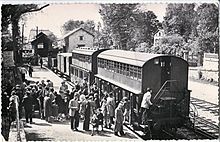

As early as 1855, the Chemins de fer de l'Ouest procured two-axle double-deck cars for the workers' trains in suburban Paris traffic. From 1933, the successor company ETAT used seven-part double-decker trains Voiture à étage État , which were in operation with tank locomotives in push -pull operation with tank locomotives up to 1982 a few years before the double-decker trains of the Lübeck-Büchener Railway .
In 1973 the car series voiture de banlieue à deux niveaux (VB-2N) was created for the RER with second class cars (164 seats), mixed-class vehicles of type ABe (66/78 seats), half-luggage car BDe (156 seats) and control car Bxe ( 134 places). With the seat division 3 + 2 in the second class and 2 + 2 in the first, the seats are narrower than on the Deutsche Bundesbahn.
The self-supporting wagons all have the same dimensions and are each 24,280 millimeters long and 4,320 millimeters high up to the top of the roof. The two large swinging double doors are designed in high-floor construction. The wagons can run on both the 1500 volt direct current network and the 25 kV alternating current network of the SNCF. The VB-2N series includes 589 cars painted in orange-gray.
An improved variant VO-N2 for the western region (Ouest) comprised 100 copies, for the northern region 51 VN-22N wagons were procured. The delivery was completed in 1987. A total of 740 double-decker cars are used in Paris suburban traffic.
Multiple units in the Paris RER
Double-decker multiple units have also been running on the Paris S-Bahn ( RER ) since 1983 . The ZR-2N intermediate cars were developed from the Banlieue cars, the two Z 5600 railcars for one unit were redesigned. This series is in use with two or three intermediate cars. There are seats on the upper floor and in the middle area, the traction equipment is located behind the driver's cabs. The doors are offset slightly in the middle of the car compared to the middle car. By 1985, 104 Z2 units had been delivered to SNCF for use on the RER line C. Community lines with the Paris transport operator RATP which was dual-system version Z 8800 procured. These 116 units are the same as the pre-series, only the railcars are slightly heavier than their predecessors because of the additional transformer . There are 48 second-class seats upstairs and 46 downstairs.
For use on lines C and D, 200 two-system trains of the Z 20500 series were delivered to the SNCF until 1988 , the railcars of which were given a modern, steeply sloping front design. At 26.4 meters, the intermediate cars were given the same length as the UIC types X and Z.
Up to 1996, 96 double-decker MI-2N multiple units had been ordered for the RER core network, with three doors on each side of the car for quick passenger exchange. They are used on lines A and E, which are operated jointly by RATP and SNCF.
The two-system railcars of the MI 09 series from Alstom and Bombardier have been used on RER line A since 2011 . These replace u. a. the single-story railcars of the MS 61 series .
Multiple units in other regional traffic
There are also double-decker multiple units for regional traffic outside the major centers, i.e. the TER networks .
The first generation was put into service from 1998 to 2000 and is called TER 2N, full series designation Z 23500 , consisting of a double-decker railcar and a double-decker control car.
The next generation was commissioned in 2000 and entered service between 2004 and 2010. It is called TER 2N NG ( NG stands for “Nouvelle Génération”) and, depending on the length, bears the series designation Z 24500 (combinations of two and three) or Z 26500 (combinations of four and five). In these multiple units, a bogie is driven on both axles under each car.
Long-distance transport
The SNCF ordered 151 double-decker cars for long-distance transport based on the model of the wagons for suburban traffic. The series includes 96 Be, 37 ABe and 18 BDxe control cars. These vehicles are painted in the livery of the Corail cars and offer more spacious seating than the cars for suburban traffic.
In high-speed traffic, double-decker multiple units are used as TGV duplexes . From 1995 to 2010, 160 trains were built in four different series. The first units were in use between Paris and Lyon.
In April 2007 the V150 set a world speed record for rail vehicles with 574.79 km / h. The train consisted of the two powered end cars of the TGV POS 4402 and three double-decker intermediate cars of the TGV Duplex modified with AGV drive technology .
In the meantime, one is quite flexible in putting together the TGVs, there are also multiple units in double traction, which consist of a TGV duplex and a single-floor TGV unit.
TGV double-deck car of the record train V150
Italy

In the 1980s, Casaralta built double-decker cars of the French type VB 2N for the Ferrovie dello Stato as well as the private Ferrovie Nord Milano (FNM) and Ferrovie del Sud Est under licenses . They were used in regional traffic.
In the 1990s the FS and FNM put the TAF electric multiple units designed for suburban traffic into service. TSR trains , an in-house development, are in use at Trenord .
In recent years, Trenitalia has used Vivalto cars for RegioExpress trains . Some cars can also be found at Trenord and Ferrovie Emilia Romagna .
Luxembourg
The Luxembourg state railway CFL uses double-decker wagons from Bombardier, which are similar to the types made by this manufacturer for the DB AG. a. with the series 4000 (similar to DB 185) in cross-border traffic to Rhineland-Palatinate , as well as the French double-decker multiple unit TER2N ng (Train Expresse Régional 2 Niveaux nouvelle génération) of the series 2200 (similar to SNCF 26500/24500) for regional traffic to France and Belgium ( SNCB ) on the Athus-Meuse line (25 kilovolt) to Virton.
Since July 17, 2014 the CFL has been operating a class 2300 multiple unit , since March 16, 2015 the CFL KISS have been running on the section between Trier and Koblenz together with the FLIRTs of the DB Regio Südwest in mixed multiple units as RE1 / RE11 of the SÜWEX .
Netherlands
Car types DDM, DD-AR, NID
At the beginning of the 1980s, traffic in the Netherlands, especially between Amsterdam and Den Helder, increased so much that new routes had to be found. For this purpose, the Dutch Railways (NS) had new lightweight double-deck trains developed by the Talbot wagon factory in Aachen. The car types were delivered to the NS. A purely second-class car, a mixed-class first and second class car and a second-class control car. These trains were initially coupled with electric locomotives of the 1600 and 1700 series, which corresponded to the SNCF BB 7200 locomotives. The train sets could run in multiple units like railcars. 10 Bv, 77 ABv and 79 Bkv control cars were delivered. These cars are 26.8 meters long, 4.60 meters high and 2780 millimeters wide. Depending on the version, the weight is between 43 and 52 tons.
In order to be able to replace the locomotives, six-axle mDDM powered end cars are now being used to match the Dosto sets as a locomotive replacement. The drive technology is located in the lower area, and there is space for 50 passengers above.
The first series of these double-decker cars, built in 1985, type DDM-1, was decommissioned in September 2010, but was temporarily taken back into service in January 2011 due to winter bottlenecks. The type DDM-2 and DDM-3 cars built between 1991 and 1994 are used in the DD-AR trains (dubbeldeksaggloregiomaterieel, for example double-decker vehicles for use in urban areas ), consisting of a control car, three intermediate cars and a locomotive of the 1700 or series a control car, two intermediate cars and an mDDM powered end car.
These DD-AR train sets were modernized in the early 2010s and are now used in intercity traffic. Under the name Nieuwe Intercity Dubbeldekker ( NID , German "new Intercity double-decker") four- and six-part multiple units are formed, each powered by a power car.
Car types DD-IRM, VIRM
For fast interregional traffic, IRM double-decker railcars were procured between 1994 and 1996, which run with the nickname Regiorunner . Its width of 3.02 meters corresponds to the ICE dimension. 290 single cars as second-class power cars and mixed-class intermediate cars were delivered, which were put together to form three or four-part multiple units. The mBk end cars with drive technology offer 93 seats. There are two types of intermediate cars. The ABv 3/4 has 47 first-class places in the upper and lower floors, the ABv 5 only 23 places in a 2 + 1 arrangement in the lower floor. In the second class, 47 or 80 seats are offered. They are listed as DD-IRM.
2001 to 2005 slightly modified IRM units were put into service, 13 four- and 12 six-part multiple units. In the six-part units, one of the intermediate cars is also powered. Due to the general increase in passenger numbers, the multiple units of the first delivery series (DD-IRM) were equipped with additional intermediate cars, so that the formerly three-part units now run as four-part units, the formerly four-part units now as six-part units. From now on the entire series is called VIRM. - Verlengd interregiomaterieel , German "extended interregio vehicles ".
On June 27th, 2008 the first VIRM-4 was presented. This once again slightly modified delivery series consists of 50 four-part vehicles. Among other things, they replaced the converted former German Bm 235 passenger coaches .
VIRM of the NS
Portugal
Double-deck cars are only used in the greater Lisbon area . In Portugal there was and still is only one series of double-deck cars, the CP series 3500 produced by GEC Alstom / CAF . Both the state-owned railway company CP ( Comboios de Portugal ) via its local transport subsidiary CP Urbanos de Lisboa and the private local transport provider Fertagus use trains of this series for S-Bahn traffic in the greater Lisbon area.
Russia
The state railway company RZD has been using night trains with 15 double-decker cars on the Moscow - Sochi - Adler connection since November 2013 . The double-deck cars are used to increase capacity on the line in view of the 2014 Winter Olympics . Maintenance is carried out in the Mineralnye Vody depot in the Stavropol region . The 50 double-decker sleeping cars ordered were developed together with Alstom and are being built in four different designs at the Tver wagon works . They are approved for a speed of 160 km / h. The first construction lot comprised 38 cars with 16 four-bed compartments, 4 cars with 15 two-bed compartments, 4 cars with 12 four-bed compartments and a service compartment, as well as 4 dining cars with 44 seats in the restaurant and 6 seats at the bar.
Sweden
In Sweden, double-decker multiple units of the Alstom Coradia Duplex type have been used as the X 40 in the densely populated Stockholm region since 2005 , and since spring 2011 also on the Stockholm - Gothenburg and Gothenburg- Malmö routes .
Soviet Union
In the 1960s, some double-deck coaches were built in the GDR for the Soviet Union with a Russian clearance profile. They were used on a trial basis in train traffic, but did not prove themselves and were then retired.
Spain

In suburban traffic in the cities of Madrid and Barcelona there are also double-deck cars built by CAF according to French licenses . There are locomotive-hauled as well as railcar sets.
The Spanish wagon construction company Talgo also developed, under the name Talgo 22 , a double-decker train that has wide passageways to the next wagon on the upper deck. The car bodies on this train are hung in such a way that the car bodies tilt slightly to the side in the curves (passive tilting technology ). The steered single wheels are located under the stands. This enables the car bodies to be built using low-floor technology . So far, however, this is only a project; no train of this series has yet been produced.
Czech Republic

Electric double-decker multiple units of the 470 and 471 series are used in regional suburban traffic in various large Czech cities . A further development of the 471 series, the 675 series, is planned for IC traffic . Locomotive-hauled trains with double-decker single wagons of the type Bmto are also used on the non-electrified routes around Prague.
United Kingdom
Double-decker cars are very common in trams and buses in Great Britain.
In principle , the small clearance profile of long-distance railways does not allow double-deck cars. However, the required rush constantly overcrowded trains in suburban traffic in the southeast of London, which (as of a newspaper even as "Sardine Special" sardine special train ) were designated, larger capacities. When the subject even got on the House of Commons agenda in 1948 , the use of double-decker cars was investigated.
Lancing and Eastleigh Works manufactured two prototypes designed by Oliver Bulleid , which were presented to the public on November 1, 1949. They consisted of two railcars , each with a driver's cab , between which two intermediate cars ran, which were designated as Class 4DD .
The seating levels of the "lower house" and the "upper house" were nested lengthways in a zigzag . Since the clearance profile was nevertheless slightly exceeded, they were only allowed to run on certain routes. The trains went through several visits to the workshop until it was decided in December 1950 not to procure any more and instead to run longer trains.
In addition to longer stopping times, as more passengers had to get on and off per door, the lack of comfort and poor ventilation, not only caused by the narrow space, were one of the reasons. The problem of space was exacerbated by the fact that the vehicles sat on conventional frames to accommodate the drive in the underfloor, which is why this area was not available as a passenger compartment.
The Bulleid Double Decker Society is trying to restore and preserve the two English railcars that have survived.
Overseas
Argentina

Trains with double-decker coaches from Toshiba ran on the broad-gauge Sarmiento Line in the province of Buenos Aires . A first prototype of these trains, built in Argentina , was delivered in 2005 and series production began in 2008.
The trains consist of single-story railcars and control cars, which are supplemented by double-decker intermediate cars. The nine-part units run on a side busbar .
Australia

In the state of New South Wales , direct-current electric double-decker multiple units have been used for suburban traffic in Sydney since the 1970s.
Several hundred carriages were built in several series marked with letters, which were put together to form four or eight-part units. They are 3 meters wide and 4.4 meters high.
China
As early as the 1960s, Qingdao in Sifang built a multiple unit with a double-decker intermediate car and diesel-hydraulic drive, but it did not go into series production.
In 1987, the CSR Wagenwerk Puscheng in Nanjing built a smaller series of air-conditioned double-decker cars with corrugated side walls, which belong to the family of Chinese 25 standard cars . The series includes second class seating cars from the SYZ25 series and first class seating cars from the SRZ25 series. They are used together with the KD25 generator car, which ensures the supply of the three-phase train busbar with 380 volts. The wagons are used in trains on routes in the densely populated coastal area, which travel at a maximum speed of 120 km / h and usually cover distances of less than 300 kilometers.
From 1991, improved versions of the double-decker cars of the 25B standard car family appeared with smooth side walls designed for 140 km / h. In addition to the second-class SYZ25B and first-class SRZ25B seated cars, the series now also included the SYW25B couchette car, the SRW25B sleeping car and the SCA25B dining car.
From 1996, double-decker cars of the 25Z family of standard cars were built for the Guangzhou – Shenzhen route, and were designed for 160 km / h for the first time. The top speed was reduced to 140 km / h in 2008. The series includes first-class passenger cars, half-luggage cars with first-class seats, upholstered second-class cars and dining cars.
In 1998 the double-decker cars of the 25K family appeared for a top speed of 160 km / h. The same types of car were built as in the 25B family, the series designations are in the same order as above SYZ25K, SRZ25K, SYW25K, SYW25K and SCA25K. In addition to CSR Puscheng, CNR Changchun also built double-decker cars of the 25K family, which, unlike the cars from Nanjing, do not have end entrances, with low entrances between the bogies.
In 1998, together with Siemens in Tangshan, two four-part double-decker diesel multiple units with Cummins diesel engines were built, but they were unsuccessful. They were decommissioned in 2006 and scrapped in 2011. A third similar train is still in use as an inspection train.
Hong Kong
An exclusively double-decker tram has operated in Hong Kong since 1904. The tram network with Cape gauge (1067 millimeters gauge) is 13 kilometers long and shares the roads with other means of transport. The power system used is 550 volts DC. There is only one route on the north side of Hong Kong Island.
India
Indian Railways has been using double-decker trains with air-conditioned cars since 2011. The cars come from the Rail Coach Factory Kapurthala . The first train ran on October 1, 2011 between Howrah and Dhanbad , the second between Bombay and Ahmedabad .
Since April 25, 2013, a long-distance train has been running between Chennai and Bangalore with double-decker cars that can hold 128 passengers. The entrances are above the bogies. There are two seats on one side of the aisle and three on the other side.
Israel

In 1999 Israel Railways ordered four double-decker train sets from Bombardier Transportation in Görlitz , which were transported to Israel by cargo ship via Rotterdam in 2001 . In 2010, 147 double-decker cars are in use. In October 2010, a framework agreement was signed for a total of 78 cars. In January 2011, the IR extended this supply contract with an option to a total of 150 units for delivery by 2012. The first vehicles from this contract were shipped to Israel in October 2011.
Japan
Trams
Type 5 double-deck cars were used on the Osaka tram from 1904 to 1911. One car was reconstructed in 1953 by building an upper deck on another tw. This Tw is today in the city tram collection at the Morinomiya subway depot.
Regional traffic
In Japan, double-decker trains are used less to increase capacity than as observation cars or green cars (first class). For the first time, double-deck cars were used in the 10000 series as the Vista Car of the Kintetsu 1958. Further examples are the other series from Kintetsu, JR Shikoku series 5000, Keihan series 8000, JR Central series 371 and the Odakyū series 2000 RSE.
In regional traffic around Tokyo, the JR East introduced two double-decker coaches per train in 1989 with the 211 series, which as a green car (first-class coaches subject to a surcharge) offer more seats than a normal multiple unit. This principle, that only about two cars per train (length per train up to 15 cars) are double-decker, has also been retained in other newer series, e.g. B. E217 (1994), E231 (2004) or E531 (2006). Apart from that, there is only one series that consists entirely of double-decker railcars for regional traffic, this is the ten-part E215.
Shinkansen
In the Shinkansen high-speed network, two double-decker cars were added to the Shinkansen class 100 from 1986 in order to be able to offer higher capacity at peak hours. A restaurant was set up on the upper deck of a double-decker car. The Shinkansen 200 series also had two double-decker cars. Both series have now been shut down. Individual cars are preserved in museums.
Due to the increasing number of passengers, the completely double-decker series E1 and E4 were developed, which can carry up to 1634 passengers per train. The twelve-part series E1 was in use from 1994 to 2012, the eight-part series E4 has been in use since 1997, but is expected to be shut down in 2016 [obsolete] .
As there is a great deal of interest in increasing the speed of Shinkansen traffic in Japan, despite the advantages that double-decker trains bring to capacity, it is expected that only single-decker trains will run in the future.
Night train service
In the night train service, the JR West uses the 285 series, a double-decker multiple unit (built in 1997) on the route from Tokyo to Izumo and Takamatsu (Sunrise Izumo / Sunrise Seto). The E26 series (double-decker cars in locomotive-hauled trains) ran until 2015, and since then there have been no locomotive-hauled night trains (Blue Train) in Japan.
Canada
In Canada, GO Transit uses its characteristic bi-level double-decker trains (green and white design with lowered entrances) with up to 12 cars in diesel traction for shuttle traffic to and from Toronto . In suburban traffic in Montréal (trains de banlieue of the Agence métropoliaine de transport ), BiLevel wagons are sometimes used, but also MultiLevel wagons . In addition, the West Coast Express is a double-decker commuter train that runs from Vancouver to Mission on the Canadian Pacific coast .
United States
In Los Angeles ( Metrolink ), Miami and Seattle there are double-decker cars that can serve the deep platforms with a low entrance on the lower level. The passages to the other cars are on the upper floor.
In Chicago and San Francisco ( Caltrain ) there are gallery cars with the upper floor designed as a gallery. This enables train staff to check tickets in one pass from the lower floor. In Chicago, double-decker interurban trains operate on the Chicago South Shore and South Bend Railroad .
The Amtrak sets in their Superliner also a double-deck coaches -Luxuszügen. Most of the seats in these vehicles are on the upper floor, while the lower floor has a compartment accessible by wheelchairs, toilets and luggage racks. These cars could only be used west of Chicago until the 1980s because the clearance profile east of Chicago was not yet sufficient.
Colorado Railcar Manufacturing built double-decker railcars and multiple units from 1988 to 2008 .
New Jersey Transit uses Bombardier MultiLevel double-deck cars in suburban traffic in New York . These cars can serve both underground and elevated platforms.
See also
literature
- Wolfgang Theurich: Double-deck vehicles from Görlitz - double high, double good . EK-Verlag, Freiburg 2004, ISBN 3-88255-347-2 .
- Pragmatic stopgap solution. The Dosto-IC is coming . In: railway magazine . No. 3/2011 . Alba publication, March 2011, ISSN 0342-1902 , p. 28-29 .
Web links
Individual evidence
- ↑ Horse-drawn tram on trambahn.de, accessed on January 1, 2020
- ^ Karlheinz Hartung, Erich Preuß : Chronicle of Deutsche Eisenbahnen 1835–1995 , transpress Verlag, Stuttgart 1996, ISBN 3-344-71038-9 , p. 37
- ↑ a b customer magazine from Knorr - Bremse ( Memento from December 19, 2013 in the Internet Archive ), November 25, 2009, "New Generation of Double-Deck Cars" (PDF; p. 5.)
- ^ The broad gauge railway ( Memento from February 1, 2012 in the Internet Archive )
- ^ Richard Kunze: Travel on two levels . In: railway magazine . No. 7 , July 2012, p. 7 .
- ↑ Olaf Bade: The 1993 double-decker coaches . In: Locomotive Report . No. 11 , November 2019, ISSN 0344-7146 , p. 8 f .
- ↑ Annual review 1992: Passenger traffic . In: Deutsche Bahn . No. 1 , 1993, p. 32-40 .
- ^ A b Christian Schlesinger, Reinhold Böhmer: Wrongly in the pillory . In: Wirtschaftswoche . No. 48 , November 25, 2013, ISSN 0042-8582 , p. 54 ( among other titles ).
- ↑ Re: Dosto control car with high entry? , on Drehscheibe-foren.de
- ^ Bombardier and Deutsche Bahn framework agreement for 800 Dosto cars. Retrieved May 12, 2019 . , In: Eurailpress.de. January 7, 2009.
- ↑ Walter Wille: Vehicles for billions, ICE for everyone. In: Frankfurter Allgemeine Zeitung. June 5, 2007, p. T1 , accessed June 5, 2007 .
- ↑ New double-decker coaches from DB Regio in Stendal christened "Johann Joachim Winckelmann". ( Memento from January 27, 2016 in the Internet Archive ) on: pressrelations.de , March 16, 2011.
- ↑ Report of the WestfalenBahn on the ceremony for the start of operations of the WestfalenBahn on the EMIL lines RE 15, RE 60 and RE 70 ( Memento from December 17, 2015 in the Internet Archive )
- ↑ Contract signed for Railway Network East. Retrieved May 12, 2020 .
- ^ A b Deutsche Bahn AG (ed.): Deutsche Bahn orders 27 new long-distance trains . Modern double-deck cars are to be used on IC lines as early as 2013. January 12, 2011 (press release).
- ↑ Increased . In: mobile . March 2011, p. 58-59 .
- ↑ a b c Jürgen Hörstel: Two-story also in long-distance traffic . In: Your train . tape 44 , no. 5 , 2016, ISSN 0948-7263 , p. 34-38 .
- ^ Bahn discovers home market: New double-decker IC without dining car . In: Frankfurter Rundschau , January 13, 2011.
- ↑ a b Jens Schmidt: Double-decker without breakfast . In: Volksstimme . November 4, 2015, p. 2 .
- ^ DB Mobility Logistics (ed.): New double-decker intercity buses will be used later . Press release from February 27, 2013.
- ↑ Dieter Fockenbrock: Delays also with the double-deck IC . In: Handelsblatt . No. 93 , May 16, 2013, ISSN 0017-7296 , p. 17 .
- ^ Peter Kirnich: More ICE trains with internet access. In: Frankfurter Rundschau . June 5, 2013, p. 16 , accessed January 28, 2018 .
- ↑ Nikolaus Doll: New Super-ICEs have communication problems . In: The world . No. 28 , February 3, 2014, ISSN 0173-8437 , p. 10 ( similar version ).
- ^ A b Johannes Dörries: Deutsche Bahn: New IC trains arrive with a delay . Report in the online edition of the Mitteldeutsche Zeitung from December 15, 2014.
- ↑ Amina Linke, Thomas Husmann: How is it going in the new double-decker Intercity? In: Nordwest-Zeitung . December 13, 2015, accessed January 28, 2018 .
- ↑ Problems with the new double-deck IC. (No longer available online.) In: tagesschau.de. Archived from the original on January 1, 2016 ; accessed on January 2, 2016 .
- ^ Peter Neumann: Trends and bizarre things at the world's largest rail fair in Berlin. Berliner Zeitung website , September 25, 2014, accessed September 26, 2014.
- ↑ a b Francis Purkerer: The double-decker intercity train in the test. In: New Westphalian . December 7, 2015, p. 5 , accessed January 28, 2018 .
- ↑ Deutsche Bahn orders double-decker wagons for IC trains
- ↑ Bahn buys new double-decker IC
- ↑ More rail for metropolises and regions: The largest customer offensive in the history of DB long-distance transport. DB Mobility Logistics AG, March 18, 2015, archived from the original on March 20, 2015 ; accessed on January 28, 2018 (press release).
- ↑ a b c More rail for metropolises and regions: The largest customer offensive in the history of DB long-distance transport. (PDF; 3.12 MiB) Deutsche Bahn AG, March 18, 2015, pp. 16, 17 , archived from the original on April 4, 2015 ; accessed on January 28, 2018 (presentation).
- ↑ The "Intercity 2" before the start of operations . In: Eisenbahn-Revue International . No. 1 , 2016, ISSN 1421-2811 , p. 48 f .
- ↑ Maximilian Rabl, Johann Stockklausner: Austrian passenger cars. Verlag Josef Otto Slezak, Vienna 1982/2003, drawing on page 70.
- ^ Swiss Industrial Society, Neuhausen am Rheinfall: 100 Years of the Swiss Industrial Society 1853–1953 . 1953, p. 142 .
- ^ Bruno Lämmli: LION project. In: lokifahrer.ch. Retrieved January 28, 2017 .
- ^ Adriana Gubler: Over 7,000 working hours per car. (PDF; 374 KiB) In: Oltner Tagblatt. December 9, 2011, p. 21 , accessed January 28, 2018 .
- ↑ The "lion" pack is complete , on nzz.ch
- ↑ Name DPZ Plus in SBB press release on Innotrans 2012. SBB press release accessed on August 17, 2012.
- ↑ SBB orders a further 24 RegioExpress double-decker trains. ( Memento from May 17, 2014 in the Internet Archive ) SBB press release. Retrieved August 17, 2012.
- ↑ Gigantic investment: SBB buy 59 new double-decker trains In: Tagesanzeiger, April 20, 2009. Accessed on April 17, 2010.
- ^ Double-deck framework . In: Railway Gazette International . tape 172 , no. 2 , 2016, ISSN 0373-5346 , p. 7 ( similar version ).
- ↑ Jens Bruun-Petersen, Ulrik Trap Jensen Danske Personvogne bane bøger 2012 ISBN 978-87-91434-34-1
- ↑ DB Regio and CFL drive in traction. zughalt.de, accessed on November 26, 2015 .
- ↑ Двухэтажный пассажирский вагон презентовали в Минеральных Водах. In: Fedpress. August 2, 2013, Retrieved August 12, 2013 (Russian).
- ↑ Dosto car for the RZD . In: Swiss Railway Review . No. 8-9 , 2013, pp. 411 .
- ↑ Модель 61-4465. Waggonbau Tver, accessed on August 12, 2013 (Russian, including technical data).
- ↑ hmmwv: China's first double decker train. In: skyscrapercity.com. January 19, 2012, accessed January 28, 2018 .
- ↑ Chennai-Bangalore AC double decker express train starts operations. The Economy Times, April 25, 2013, accessed April 28, 2013 .
- ↑ Israeli State Railways commissions Bombardier to deliver 78 double-decker cars Press release from Bombardier Transportation, October 22, 2010.
- ↑ eisenbahn-kurier.de January 16, 2011: Israel orders more double-decker cars from Görlitz
- ↑ Görlitz: First double-decker cars on the way to Israel , on hitradio-rtl.de, accessed on May 12, 2019
